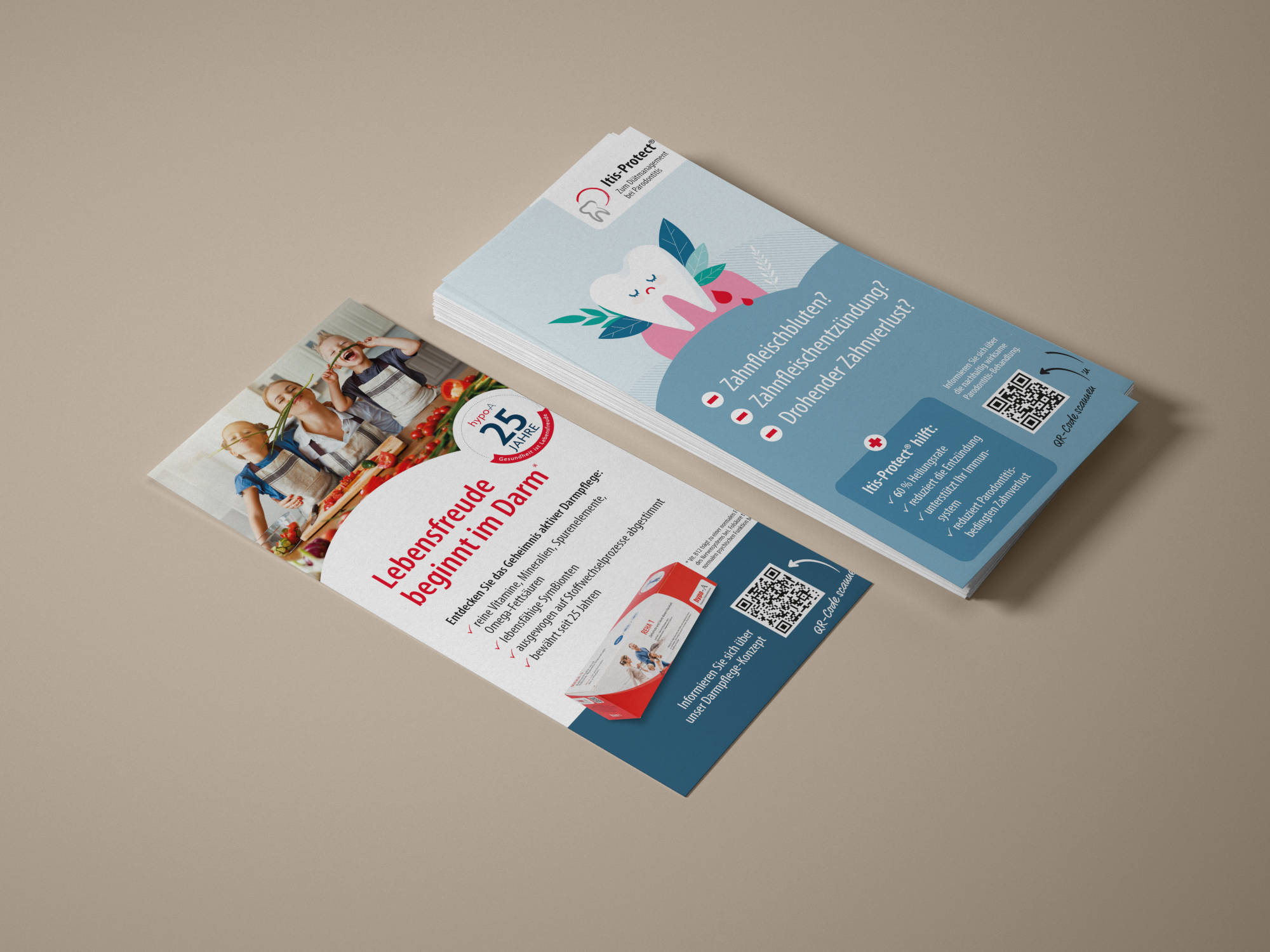02/11/2023
Dental health - the right care

From the very first tooth, regular dental care becomes part of our everyday lives. At first, it's a playful way of battling tooth decay and bacteria, but in adolescence it's often done reluctantly - and later routinely, because well-groomed teeth not only look nicer, but also result in less unpleasant, expensive dental treatment.
So you'd think we'd all be able to brush our teeth in our sleep.
But far from it: there are still contradictory myths and uncertainties surrounding the frequency, technique and "working material" of dental care.
Shaking or circling, dental floss or interdental brushes, electric or by hand? There is a great deal of uncertainty.
A few years ago, a representative survey was conducted to find out how Germans brush their teeth: According to this, every second adult brushes their teeth incorrectly, too briefly or with too little concentration(1).
For all those who now want to take a closer look at their own oral hygiene, here is an overview of the most important rules for proper dental care:
The right tooth brushing technique
For a long time, circular brushing movements, the rotation technique, were recommended when brushing teeth. These fell into disrepute due to the risk of pushing bacteria under the gum line.
Today, the bass technique, a vibration method, is considered optimal, but it requires a lot of patience and time.
The most important thing is to brush your teeth regularly and systematically, paying attention to the following:
- Do not press on too firmly
- Do not use a hard toothbrush (in both cases there is a risk of injury to the gums) Consider all tooth surfaces
- Concentrate on brushing your teeth and not just brush "on the side"
Frequency and timing of tooth brushing
Right after getting up, after every meal, three times short or once long?
The rule of thumb is:
Brush for at least two minutes at least twice a day and also clean the spaces between your teeth at least once a day. Ideally, you should clean your teeth after every main meal and avoid snacks between meals.
However, it is important to wait at least 30 minutes after eating before brushing. This is because food acids dissolve minerals from the enamel and weaken it.
The result: the friction of the toothbrush can attack the important protective layer. After about half an hour, the teeth are mineralised again by the saliva and can be brushed safely.
If this doesn't work out, you can rinse your teeth with water after eating and brush them again at the next opportunity. You can neutralise acids from fruit, juices and sweets even more effectively with an alkaline solution. Simply dissolve a pinch of alkaline powder, such as Kaisernatron, magnesium or calcium carbonate, in a little water or saliva and suck the liquid through the interdental spaces.
Dental floss or interdental brush?
It is not enough to brush the chewing surfaces, front and back of the teeth. The spaces between the teeth, the interdental surfaces, must also be cleaned of unwanted bacteria and plaque.
The best-known aids for this are dental floss and interdental brushes. As with the brushing technique, there are conflicting recommendations as to which method is better. And again, this is a personal decision that depends on what you are more comfortable with.
While dental floss is particularly suitable for cleaning the contact points between the teeth, the brushes are more thorough in the interdental space. Also make sure you use the right size. You should feel a slight resistance when pushing through, but you should still be able to get through easily. You may need different sized brushes for different interdental spaces. Ideally, you should combine dental floss and interdental brushes.
If this is too much for you, you are doing your dental health a big favour by using dental floss or interdental brushes at least once a day. Only use the dental floss once at a time and the interdental brushes should be replaced after 5-6 uses.
Electric or manual toothbrush?
You also have a choice when it comes to the type of toothbrush. In general, a distinction is made between the classic manual toothbrush and an electric toothbrush; sub-types of these are the sonic and ultrasonic toothbrushes.
- Hand toothbrushes differ in particular in the type and size of the brush head and the hardness of the bristles. The oscillating toothbrush is the classic electric toothbrush. It usually has a small round head that rotates up to 8,000 times per minute,depending on the model.
- Sonic toothbrushes have an elongated brush head, unlike oscillating toothbrushes. A microchip generates a sound that causes the bristles to vibrate. Ultrasonic toothbrushes achieve more than 16,000 vibrations per second. The cleaning effect is generated by the sound itself, not by vibration.
Anyone wondering which type of toothbrush is the best should not confuse high-tech and cleaning performance. In fact, electric toothbrushes perform slightly better than manual toothbrushes when it comes to plaque removal. This may also be the reason why people who have no or only minor problems with their gums and periodontitis can prevent tooth loss due to periodontitis more effectively with an electric toothbrush than with a manual toothbrush (2). However, electric toothbrushes are also considerably more expensive.
More decisive for cleaning success than the type of toothbrush are the technique, frequency and length of brushing. So if you achieve good results with a manual toothbrush, you don't need to switch. If you enjoy the technical features of electric toothbrushes (time signal, pressure sensor, smartphone interface) and are therefore more motivated to brush your teeth, you can treat yourself to an electric model.
An electric toothbrush is clearly recommended for people with motor impairments. Anyone who has problems using a toothbrush safely due to age or illness can achieve better brushing results thanks to the vibrations of an electric toothbrush (a simple model is sufficient here).
Regular replacement of the brushes is also important for optimum cleaning results. Replace them after three months at the latest, but also after colds or herpes attacks, for example.
Clean your teeth without chemicals
Watch out for additives in dental care products too. Microplastics should have disappeared from all toothpastes by now. If you also want to avoid other questionable substances such as PEG derivatives, opt for natural cosmetics. In his tip, Peter-Hansen Volkmann shows that it's even easier:
Nutrition is good, but so is control
.We all know that sugar and sugary foods are bad for our teeth. If you still want to enjoy chocolate or a piece of cake, you should do so as part of your main meal, after which you should brush your teeth. And if you get a sweet tooth in between meals, you can reach for your toothbrush afterwards to stay on the healthy side. It is particularly important not to eat and snack constantly throughout the day so that teeth and tooth enamel are not attacked around the clock. Ultimately, what's good for the body also keeps teeth healthy: wholesome, varied meals a few hours apart, preferably organic.
Of course, even the best care and diet are no substitute for a regular check-up at the dentist. Have a specialist look at your teeth twice a year and, if recommended, have a professional dental cleaning carried out to remove any plaque that has crept onto your teeth.
Literature sources
(1) Study on the toothbrushing behaviour of Germans by Witten/Herdecke University on behalf of AXA and in cooperation with Forsa: https://www.presseportal.de/pm/53273/2330958
(2) Pitchika, V. et al.: Long-term impact of powered toothbrush on oral health: 11-year cohort study. J Clin Periodontol. 2019. doi: 10.1111/jcpe.13126






























